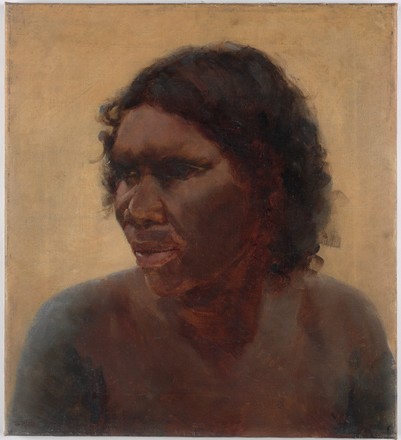Maria Yulgilbar
c1895
Oil on canvas
Bequest of Sir William Dixson, 1943
DG 319
Tom Roberts is best known as a landscape painter, but much of his income came from portraits. Most were commissions, the bread and butter work of a professional artist. ‘One had to make a living, as a 1st job, + so t’was portraiture for that + I did ‘em’ [1].
As early as 1887 he was mocking such work with the ditty:
I’ve painted kids in every pose,
A’kissing their mammie or smelling a rose,
I’ve painted ‘em in the nurse’s lap,
And in the cradle sucking pap. [2]
At the same time, Roberts’ interest in painting portraits of Aboriginal people was very much informed by his belief that he was recording an endangered race. His passionate belief in the righteousness of the British Empire and race meant that while he rendered many of his Aboriginal sitters with great humanity – Maria Yulgilbar is a beautifully executed and sophisticated example – he also saw his Aboriginal portraits as historical works of anthropological importance.
Roberts wanted his series of Aboriginal portraits kept together since
‘the interest of such a collection, if broken up, would be to a great extent
lost, especially when one considers how interesting such a group would be to us
now, of similar types of, say fifty years ago’.*
Footnotes
* Bulletin, 8
September 1900, 'Red page'
In 1895 Tom Roberts wrote to a friend about his visit to Yulgilbar: ‘Went to Yulgilbar E. D. Ogilvie to paint
blacks having a letter from P. G. King.Only
did one head of a native but an opus of the Chief aged 80 with no sign of
mental failure, military type, in mind + physique, I got along first rate with
him disagreeing at nearly every point.’*
Footnotes
* Roberts to SW Pring, 16 January 1895, Pring Papers,
Mitchell Library MSS 1367, vol 2, p 23
It was common
practice among station owners to use the name of the property as a surname for
the Aboriginal people living and working there.
When the Art Gallery of NSW purchased Tom Roberts’ portrait of Charlie
Turner, an Aboriginal man, in 1892, a reviewer noted that its ‘value will grow
year by year with the gradual disappearance from our midst of the original
possessor of the soil’.*
Footnotes
* Sydney Morning Herald, 2 September 1892, p 2.
Forty per cent of the 780 recorded images by Tom Roberts are portraits.
These include portraits in ink, oil, pastel, plaster and pencil.
Roberts was
one of the first Australian artists to rally for the establishment of a
national portrait collection to promote portraiture, contribute to Australian
self-awareness and perhaps supplement his income!



 Back to list
Back to list